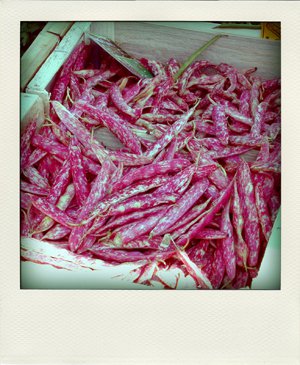Last time I was in London, my primary objective may have been to snuggle up with my nephew, but I still brought a list of food places I wanted to check out, for, you know, research purposes. One of them was Ottolenghi, a deli that offers a daily selection of colorful dishes — with an emphasis on fresh produce — and dazzling pastries.
I had received a review copy of their seductive cookbook a couple of months before, and had quickly stopped tagging the recipes that appealed to me when I realized I was placing a sticker on every page. This was my kind of food, and I was eager to taste it at the source.
After baking, the cake is further stickified by a generous brushing of brandy syrup, and left to cool. This produces a voluptuous cake that is moist-crumbed and deeply aromatic (but not at all boozy).
I visited the Kensington location (now closed), which happens to be around the block from the large Whole Foods store that was also on my list. I ogled the spectacular lineup of cakes, but decided instead on an assortment of salads to eat on the Eurostar that evening.
They were delicious, though it dawned on me halfway through that the reason why these salads seemed so pleasing was that most of them were pretty sweet, incorporating dried fruits or candied nuts or a sweetish dressing. Is it always so, or was it just an oddity on that particular day? A repeat visit is in order to find out, but I thought I’d keep that penchant in mind for when I tried savory recipes from the book.
As it turns out, the recipe I tried first was for a cake — and now that I think about it, I reduced the amount of sugar in that one, too. The recipe in question is the sticky chocolate loaf on page 219: it tugged at the strings of my heart because of the happy qualifier “sticky” — always a good omen when attached to a cake name — and because it was a chocolate cake that involved prunes, which I am fond of, and always keen to rehabilitate.
I made a few further modifications to the recipe, baking it in a cake pan rather than two mini loaf pans, substituting yogurt for the oil (the original called for yogurt and oil; I used yogurt only), and using maple syrup rather than treacle.
I hope the apparent length of the recipe below won’t scare you off; this is not a complicated cake to assemble at all. Half of the prunes are blended into the batter, in which they act as a sweetener and moisture booster, while the other half is soaked in brandy and pressed into the batter. After baking, the cake is further stickified by a generous brushing of brandy syrup, and left to cool. This produces a voluptuous cake that is moist-crumbed and deeply aromatic (but not at all boozy), and one I plan to make again soon, possibly in cupcake form.
~~~
If you’d like to read more about Ottolenghi, check their blog, which features some recipes, and read Yotam Ottolenghi’s weekly column in the Guardian, The New Vegetarian.








